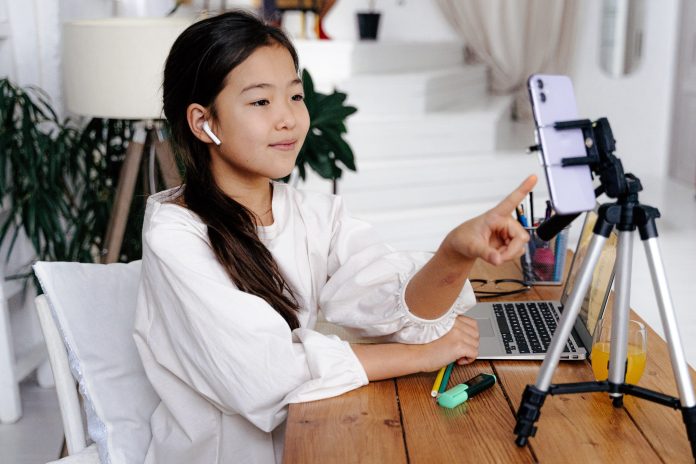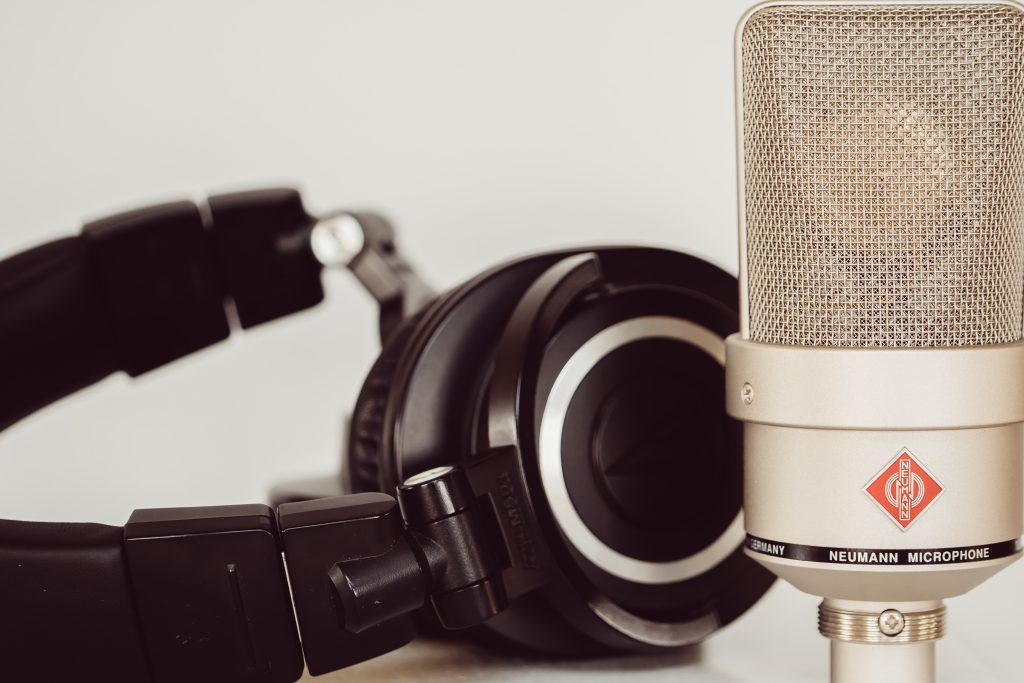
Article journalistique, texte d’humeur, enregistrement audio, tournage vidéo, message publicitaire, ce n’est pas d’hier que des enseignantes et des enseignants réalisent des productions médiatiques avec leurs élèves. Les possibilités se multiplient néanmoins au fur et à mesure que les moyens de production se simplifient et que les technologies offrent de nouvelles occasions de diffusion. Avec le temps, le journal étudiant, publié sur papier, a fait place au blogue, la radio étudiante est devenu balado. Et que dire de la production vidéo? Plus besoin de transporter un arsenal de caméras et de fils pour réaliser un court métrage! Un simple téléphone intelligent peut maintenant suffire dans bien des cas.
Ces projets à saveur médiatique ont d’ailleurs le potentiel de motiver les élèves pour différentes raisons. Non seulement, ils sont placés dans l’action, mais ils doivent aussi faire appel à leur esprit créatif et critique, à leur débrouillardise et à leur sens de l’organisation. Le travail d’équipe est généralement au programme. Et s’ils peuvent en plus choisir le thème sur lequel ils travailleront, alors là, ils seront conquis puisqu’ils pourront mettre leurs connaissances en valeur.
« La création de médias est une façon de permettre aux élèves qui n’ont pas souvent l’occasion d’exceller de montrer ce dont ils sont capables. Les élèves qui ont de la difficulté lors d’évaluations traditionnelles, ou pour lesquelles ils ne démontrent aucun intérêt, peuvent s’épanouir lorsqu’ils ont la chance de travailler avec un média qui les intéresse et de communiquer dans un langage qui a du sens pour eux. La création de médias sert de lien entre la classe et le monde dans lequel vivent les élèves lorsqu’ils ne sont pas à l’école », croit aussi Matthew Johnson, directeur de l’éducation chez HabiloMédias, principal organisme d’éducation aux médias au Canada.
Par ailleurs, la démocratisation des technologies a aussi ouvert la porte à de nouvelles possibilités de diffusion. Ainsi, quand les élèves peuvent diffuser leurs réalisations sur le Web, cela a un effet supplémentaire sur leur engagement à la tâche. Pas question de produire uniquement pour « l’école » ou leurs parents : un vrai public pourrait entrer en contact avec leurs productions, les commenter, les partager même, dans certains cas. Ce faisant, ils deviennent des créateurs dans l’univers numérique plutôt que de simples consommateurs de contenu. N’est-ce-pas emballant?
Comme enseignante ou enseignant, il peut néanmoins être déstabilisant de commencer une production médiatique avec des élèves. Les recherches d’HabiloMédias démontrent d’ailleurs que « la plupart des enseignants canadiens ne créent pas de médias en classe ». Pourtant, la création de médias serait l’une des activités les plus stimulantes pour les élèves.
Par où commencer? Quel outil utiliser? Comment diffuser les réalisations? Comment les évaluer? Dans ce dossier, nous souhaitons précisément répondre à ces questions. Au passage, nous en profitons pour aborder l’essentielle éducation aux médias. En effet, qui dit production médiatique dit aussi recherche d’information, importance de citer ses sources et sensibilisation à la qualité de l’information retransmise.
La gamme de produits médiatiques que les jeunes peuvent créer est vaste : blogues, balados, vidéos, musique, sites Web, applications, jeux vidéo, etc. Nous nous limiterons aux blogues, aux balados et aux vidéos dans ce dossier. Vous verrez néanmoins que le point de départ est généralement le même et que les démarches comptent plusieurs similitudes. Finalement, la diffusion des productions est toujours source de fierté pour les élèves. De quoi se donner le goût de recommencer!
Table des matières
- Le point de départ
- La nécessaire éducation aux médias
- Le blogue scolaire
- La baladodiffusion
- La vidéo
Conclusion
1. Le point de départ
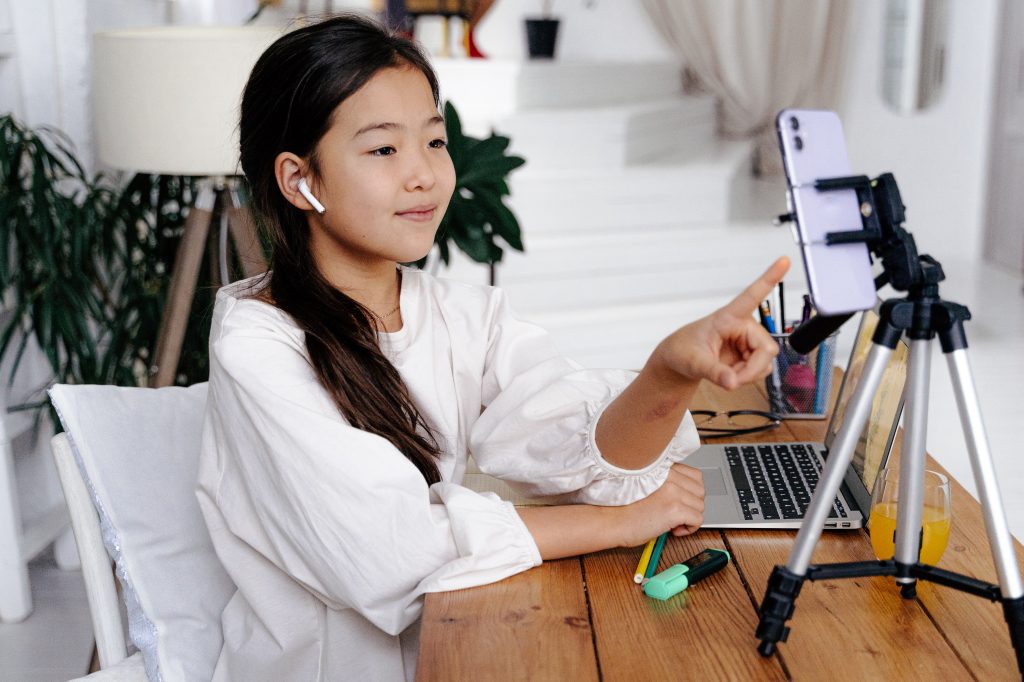
Pour tous
La création médiatique peut s’appliquer de la maternelle à la fin du secondaire (12e année), et même au-delà! Elle peut être utilisée pour évaluer l’apprentissage des élèves dans l’ensemble des matières. Effectivement, les médias concernent tous les sujets et tous les groupes d’âge. Il s’agit simplement d’adapter les tâches à réaliser et l’ampleur du projet en fonction du niveau scolaire.
La compétence numérique
La production médiatique numérique représente une bonne façon de permettre aux élèves d’acquérir des connaissances sur des sujets variés tout en développant leur compétence numérique.
À tout coup, la production médiatique permet de travailler sur plusieurs dimensions de la compétence numérique :
- production de contenu,
- collaboration,
- communication,
- culture informationnelle,
- habiletés technologiques,
- etc.
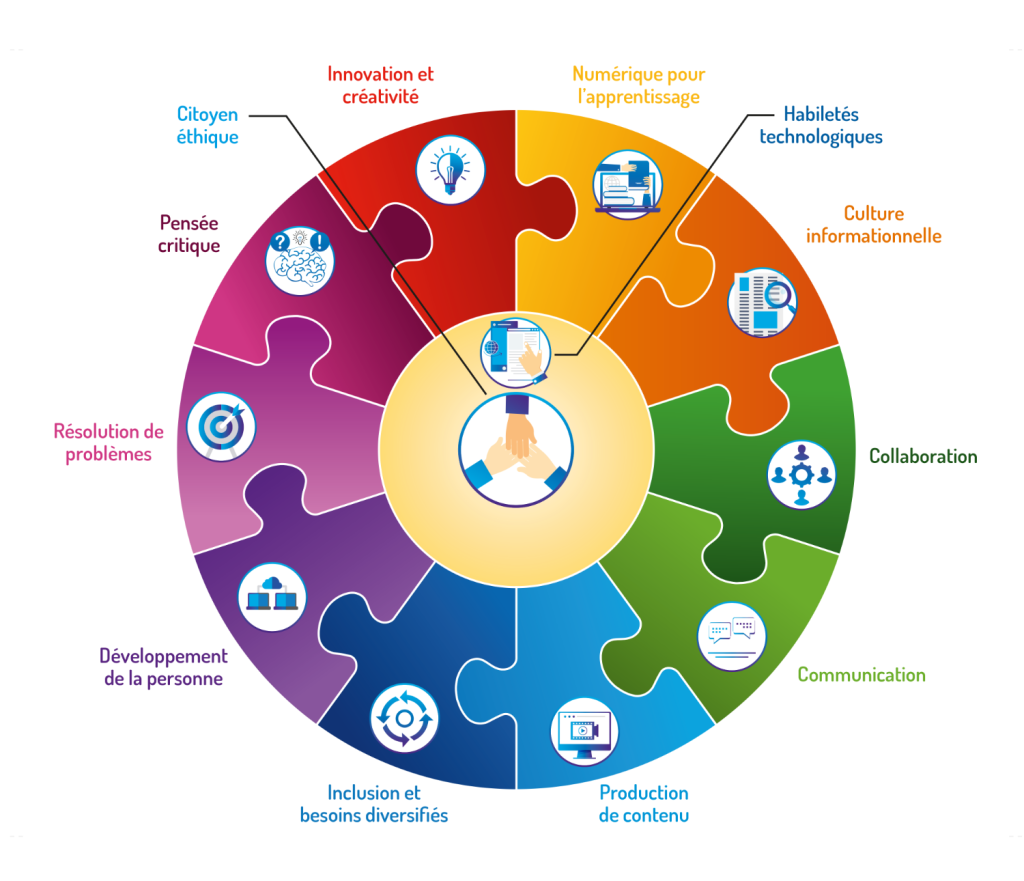
L’intention pédagogique
Comme c’est le cas dans tout projet scolaire, tout devrait débuter avec une intention pédagogique. Il ne s’agit pas de faire un projet « de plus » avec les élèves, mais bien d’utiliser le projet médiatique pour traiter d’un sujet prévu dans sa planification.
Par ailleurs, vous pouvez aussi vous référer au cadre de catégorisation des objectifs pédagogiques, la taxonomie de Bloom, pour vous guider dans la mise en place de la séquence d’apprentissage à réaliser par les élèves. Cela vous aidera à déterminer vos objectifs.
L’évaluation
La grille d’évaluation pourra être construite à partir des éléments de contenu que vous désirez retrouver à l’intérieur de la production. Ce n’est pas un concours d’habileté technique et le rendu n’a pas à être de qualité professionnelle (cela peut être bien de le rappeler aux élèves qui pourraient être tentés de rechercher la perfection). La créativité et l’originalité pourront aussi faire partie des critères d’évaluation. S’il s’agit d’une production audio ou vidéo, souhaitez-vous évaluer l’expression orale? Par ailleurs, vous pouvez aussi demander aux élèves de créer un plan de travail et évaluer celui-ci.
Il peut être intéressant de bâtir la grille d’évaluation à partir d’un exemple réussi que vous pourrez examiner en détail avec les élèves. D’ailleurs, il est toujours inspirant (et sécurisant) pour les élèves de pouvoir consulter des exemples (ou même des contre-exemples) de productions déjà réalisées, que ce soit par d’autres élèves ou par des professionnels.
L’échéance
Il est essentiel de prévoir un certain nombre de périodes de classe pour réaliser la production médiatique, en fonction de l’ampleur du projet. Tous les projets médiatiques demandent un peu de planification, surtout si vous avez besoin d’emprunter du matériel (ex. chariot d’ordinateurs ou de tablettes) ou de réserver du temps dans un local (ex. laboratoire créatif, bibliothèque) pour la production. De plus, vous pouvez aussi décider de laisser du temps aux élèves pour terminer un projet à la maison (ex. pour faire des enregistrements et du montage).
Encore une fois, cela permettra de guider les élèves dans la réalisation du projet (ex. une période pour le choix du sujet et le début de la recherche, une période pour terminer la recherche, une période de production, etc.). Ils seront en mesure de mieux organiser leur temps de travail.
Le choix des outils
« Il n’est pas nécessairement vrai que les élèves connaissent davantage la technologie que leurs enseignants; en fait, certaines études révèlent exactement le contraire », lit-on dans le Guide de classe, La littératie numérique intégrée à votre pratique en classe d’HabiloMédias.
Ce qui est vrai par contre, c’est que les jeunes apprennent rapidement les fonctions de base des outils technologiques. Une bonne pratique consiste donc à proposer quelques outils, à laisser les élèves choisir ceux qu’ils utiliseront puis à valoriser leur aisance en les amenant à devenir les experts auprès de leurs camarades. Les enseignants n’ont pas à maîtriser tous les outils. De nombreux tutoriels sont disponibles en ligne pour apprendre à les utiliser. Les enseignants vont plutôt guider les élèves dans la recherche efficace d’information et de ressources.
« Pour mener un projet, au lieu d’enseigner la façon d’utiliser un outil de création vidéo en particulier, j’ai donné des choix aux élèves. S’ils voulaient essayer quelque chose, je les encourageais à l’apprendre d’eux-mêmes », confie Matthew Farber, de University of Northern Colorado.
Le coapprentissage
Avant de commencer un nouveau projet, il est toujours intéressant d’en discuter avec des collègues. Y en a-t-il parmi eux qui ont déjà intégré ce type de projet à leur enseignement? Ou qui connaissent des outils numériques pertinents? Peut-être que certains souhaiteront se lancer en même temps que vous. Vous pourrez alors vivre l’expérience ensemble. Ainsi, vous pouvez vous conseiller mutuellement et apprendre, tout comme vos élèves! En plus d’être motivant, c’est une approche sécurisante pour tous.
Le partage
Il existe maintenant toutes sortes de manières de faire connaître les productions de vos élèves. Il n’y a plus aucune raison de les garder privées, surtout si on ne voit pas directement les visages des élèves et qu’elles ne comprennent pas d’informations personnelles. Pour publier les productions sur le Web, nous présenterons différentes possibilités plus loin dans ce dossier. Pour les partager avec la communauté, envisagez l’infolettre de votre école, les réseaux sociaux (Twitter, Facebook) ou même l’École branchée!
Si les élèves ont moins de 13 ans, vous pouvez créer un compte de classe sur les réseaux sociaux pour éviter qu’ils ne publient eux-mêmes. Dans tous les cas, vous pouvez les laisser publier de façon anonyme pour éviter des situations gênantes (n’oubliez pas de garder un suivi des pseudonymes utilisés!).
2. La nécessaire éducation aux médias

Avant de passer au volet créatif d’une production médiatique, il est pertinent de consacrer un moment au volet informationnel. En effet, qui dit production médiatique dit nécessairement recherche et organisation d’information, importance de citer ses sources et sensibilisation à la qualité de l’information retransmise. Ce n’est pas parce que les jeunes utilisent les technologies qu’ils sont des chercheurs efficaces et qu’ils respectent le droit d’auteur. De plus, il est pertinent qu’ils soient initiés à l’univers des médias, ceux-ci ayant vu leur modèle d’affaires complètement transformé avec le développement des technologies numériques.
Les chercheurs Normand Landry et Sonia Lefebvre ont déjà établi 5 raisons pour s’investir dans une démarche d’éducation aux médias :
- Développer des compétences qui permettront aux étudiants d’utiliser les technologies médiatiques numériques de manière optimale et d’en comprendre le fonctionnement;
- Développer chez les étudiants un regard critique sur les médias, les contenus médiatiques et les acteurs qui produisent et diffusent ces contenus;
- Favoriser l’adoption d’une conduite éthique et responsable avec les médias, particulièrement sur Internet et les réseaux sociaux;
- Développer chez les étudiants des compétences informationnelles, notamment par la recherche et l’analyse de l’information;
- Développer des compétences qui permettront aux étudiants de s’exprimer et d’exercer leur créativité à l’aide des technologies médiatiques.
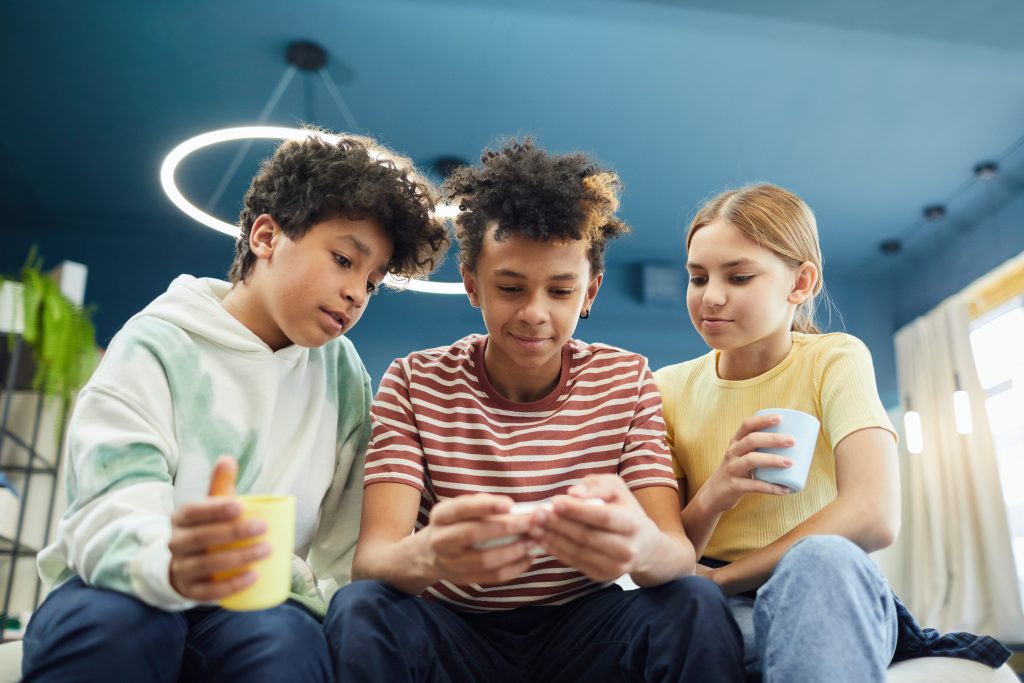
Le Centre québécois d’éducation aux médias propose entre autres une ressource expliquant ce qu’est l’éthique journalistique. Celle-ci permettra aux jeunes de comprendre les règles qui encadrent le travail des médias et qui assurent la crédibilité des journalistes. Dans un contexte où vos élèves s’informent abondamment sur les réseaux sociaux (pour ne pas nommer TikTok en particulier), il peut s’avérer pertinent d’aborder ce thème avec eux. Les journalistes doivent être rigoureux et s’assurer que les faits qu’ils rapportent sont véridiques; les jeunes apprenants devront en faire tout autant dans leurs propres productions.
Voici d’autres ressources pour vous guider :
Sur le développement des compétences informationnelles
- L’urgence d’éduquer aux médias (numéro du magazine École branchée consacré au sujet)
- Développer ses compétences informationnelles (autoformation de Campus RÉCIT)
- Démystifier les compétences informationnelles : planifier, chercher, évaluer et utiliser l’information (un dossier réservé aux abonnés du magazine École branchée)
- Développer et mobiliser sa culture informationnelle (un épisode du balado Le plan numérique)
Sur la recherche d’information efficace
- Comment chercher dans Internet de façon efficace? (Fiche d’HabiloMédias)
- Repérer les sources de l’information (CQÉMI)
- Comment authentifier une image? (CQÉMI)
- Des conseils pour vérifier les images en ligne (L’École branchée)
- Faire une recherche, ça s’apprend (Martine Mottet, professeure en technologie éducative à la Faculté des sciences de l’éducation de l’Université Laval)
Sur le droit d’auteur
- Guide interactif des droits d’auteur en milieu scolaire (un site du Centre de services scolaire des Milles-Îles)
- Démystifier le droit d’auteur appliqué aux œuvres numériques en éducation (un dossier de l’École branchée)
Sur la manière de citer des sources
- Citation de sources (Université Laval)
- Propriété intellectuelle : les concepts-clé (Fiche d’HabiloMédias)
3. Le blogue scolaire

La rédaction de texte a toujours fait partie du monde scolaire. Et si vous proposiez aux élèves de tenir leur propre blogue ou journal en ligne?
Un exemple d’hier
En 2002, Mario Asselin, aujourd’hui député à l’Assemblée nationale du Québec, était directeur de l’Institut Saint-Joseph, une école primaire privée de Québec, lorsqu’il a mis en place un programme bien particulier. Chaque élève du 3e cycle (5e et 6e année) avait son propre blogue et publiait publiquement ses créations et ses réflexions. Le projet de Cyberporfolios est présenté sur le blogue de M. Asselin. « Apprendre à publier » est encore aujourd’hui un concept qui lui est cher.
Un exemple d’aujourd’hui
À l’École secondaire de Rivière-du-Loup, les élèves publient désormais leur journal scolaire directement en ligne sur un site Web. En plus des articles journalistiques et des chroniques, l’INNÉdit contient aussi des entrevues diffusées en balado et des booktubes, critiques littéraires en vidéo. Les trois genres médiatiques se retrouvent donc dans le journal étudiant! Pour sa part, le journal étudiant de l’école Saint-Jean-Baptiste de Longueuil est aussi accessible en ligne sur une plateforme Wix, tout comme plusieurs autres!
Un exemple d’activité à réaliser :
- Rédaction d’un article de journal (HabiloMédias)
- La collection d’activités SCOOP! par l’École branchée regorge d’idées où la production médiatique, dont la publication de texte sur un blogue, peut agir comme trame de fond aux apprentissages et à l’enrichissement.
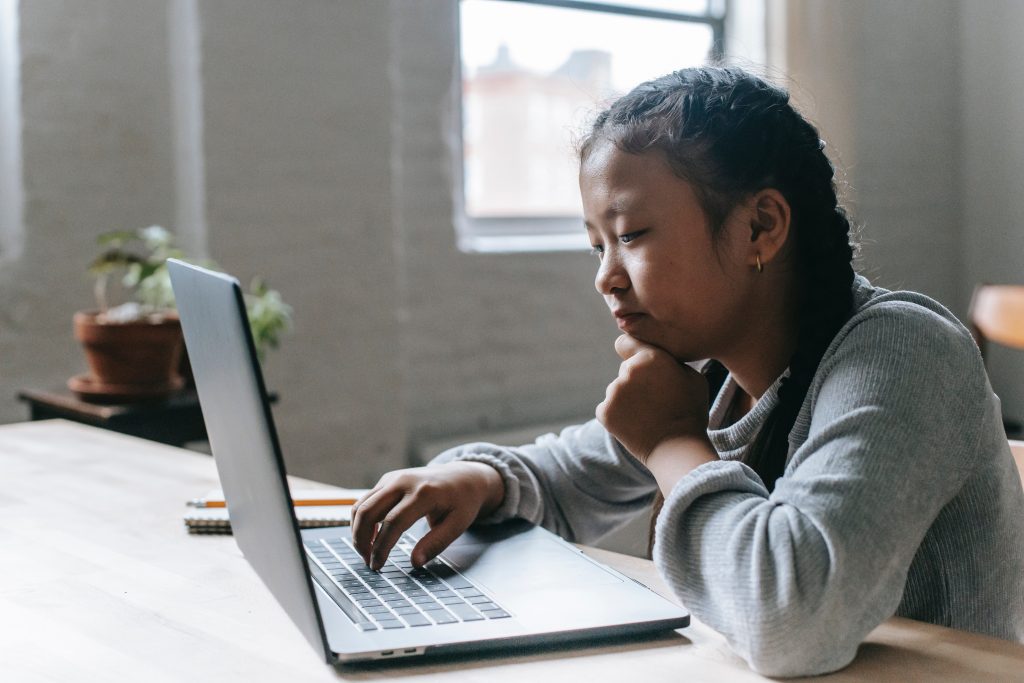
Des outils pour bloguer
Rédaction :
- Google Documents
- Microsoft Word
- Apple Pages
- Canva (autant pour le texte que pour les images)
Correction :
- Antidote
- Usito
- LanguageTool
- Recherche Spotlight sur iPad
Publication :
Se former :
- Autoformation Écriture collaborative (CADRE21)
Avec le déploiement des outils numériques, la radio scolaire a fait place au balado. Même s’ils ont beaucoup en commun, le balado offre une plus grande liberté de création aux jeunes.
Un exemple d’hier
En 2010, la Commission scolaire de Montréal encourageait ses écoles à mettre en place des radios scolaires et un site Web avait été mis en ligne pour devenir la vitrine de ces projets. « La radio scolaire permet l’acquisition de multiples compétences et stimule la curiosité des jeunes. Au cours de leurs activités de radio, les élèves peuvent mettre en pratique des notions pédagogiques de leur programme. Chaque étape de cette démarche fait appel à la créativité des enfants : recherche, rédaction, expression orale, travail d’équipe, reportage, entrevue, débat, présentation, création ou interprétation de chansons et de musique, radio théâtre, etc. », lit-on sur le site.
Un exemple d’aujourd’hui
Mathieu Mercier, enseignant d’univers social à la Polyvalente de Rivière-du-Loup, a réalisé plusieurs projets de balado avec ses élèves du premier cycle du secondaire. Il a récemment entamé la création d’une série portant sur les enjeux liés aux territoires à l’étude en 2e secondaire dans le programme de formation de l’école québécoise. Le plus récent porte sur l’accès à l’eau potable dans les communautés autochtones du Québec et du Canada. Il signe d’ailleurs un article dans le numéro d’hiver 2022-2023 du magazine École branchée sur ce sujet : Le balado comme outil d’éveil à des enjeux sociaux.
Des exemples d’activités à réaliser
Travailler le territoire à risques en abordant les enjeux et mesures mises en place pour les contrer, ainsi que les caractéristiques reliées aux risques naturels en lien avec le programme de Sciences.
- Projet de classe : Un balado pour prendre conscience des bruits ambiants
- La collection d’activités SCOOP! par l’École branchée regorge d’idées où la production médiatique, dont le balado, peut agir comme trame de fond aux apprentissages et à l’enrichissement.
Des outils pour faire les balados
Préparation/Rédaction du texte :
- Google Documents
- Microsoft Word
- Apple Pages
Enregistrement :
- Soundtrap
- GarageBand
- Bandlab
- Anchor
- Dictaphone de l’appareil mobile
Montage :
Diffusion :
- Plateforme BaladoWeb (propulsé par le RÉCIT et BAnQ)
- Anchor (qui permet de diffuser gratuitement sur Spotify et les autres plateformes numériques populaires)
- Google Sites
- Sway (Microsoft)
- SoundCloud (payant et limité)
- On peut aussi publier facilement dans les outils comme Google Présentations et PowerPoint. On ajoute simplement l’audio aux diapos.
Se former :
- Autoformation La balado pédagogique (CADRE21)
La production de vidéo avec des élèves demeure un type de projet plus engageant. Néanmoins, le matériel s’est beaucoup simplifié avec le temps et il n’est plus aussi complexe qu’avant de réaliser des vidéos. À partir d’un appareil numérique de base, les jeunes peuvent généralement arriver à des résultats très satisfaisants.
Disons-le aussi, c’est désormais le médium qui prévaut auprès des jeunes pour transmettre de l’information. Les réseaux sociaux en ont d’ailleurs beaucoup simplifié la diffusion.
Un exemple d’hier
Les plus vieux se souviendront peut-être de la popularité des « lipdub » dans les écoles aux débuts des années 2010. Il s’agissait d’un vidéoclip scénarisé dans lequel les élèves (ou le personnel scolaire) mimaient les paroles d’une chanson populaire. En juin 2011, des élèves finissants de l’école primaire Wilfrid-Bastien de St-Léonard à Montréal en avaient d’ailleurs réalisé un sur la chanson Waka Waka (This Time for Africa), de Shakira. Nous avons retrouvé cette perle sur YouTube.
Un exemple d’aujourd’hui
L’Office national du film du Canada propose un nouvel atelier en ligne pour initier les jeunes de 13 à 18 ans à la production de récit numérique. L’École des médias, disponible en français et en anglais, se déploie en 11 modules qui permettent d’apprendre les rudiments du récit numérique sur un ordinateur. Choix d’un sujet, structure d’un récit, prise de vue, montage, recherche, écriture de la narration font partie des thèmes touchés par les modules.
Nous avons d’ailleurs parlé à une enseignante qui utilise la plateforme avec ses élèves. Ne manquez pas de lire cet article ici.
Des exemples d’activités à réaliser :
- Production d’un téléjournal (HabiloMédias)
- « J’ai réalisé deux films en réalité virtuelle contre le harcèlement avec mes élèves » (un projet de Laurent Di Pasquale, enseignant en Belgique, présenté dans l’École branchée)
- La collection d’activités SCOOP! par l’École branchée regorge d’idées où la production médiatique peut agir comme trame de fond aux apprentissages et à l’enrichissement.
Pour plus de conseils sur la production vidéo, on peut visionner cette formation gratuite avec Stéphane Hunter, d’Escouade Multimédia. Les abonnés peuvent aussi lire son article paru dans le numéro d’hiver 2022-2023 du magazine École branchée : 4 utilisations de la vidéo en contexte pédagogique.
Des outils de production vidéo
Préparation/Rédaction :
- Google Documents
- Microsoft Word
- Apple Pages
- Modèle de chaîne YouTube (par Matt Miller, en anglais)
- Modèle de planification d’une vidéo (par Matt Miller, en anglais)
- Modèle de structure d’un récit (par Matt Miller, en anglais)
Enregistrement/Montage :
Diffusion :
Se former :
- Autoformation Vidéo créative (CADRE21)
La réalisation de projets de production médiatique peut sembler imposante pour certains enseignants. Elle permet néanmoins de stimuler la créativité des élèves au maximum en les amenant à créer des œuvres originales. La motivation et l’engagement seront au rendez-vous! Du même coup, les élèves sont informés au sujet de l’univers des médias et développent des compétences informationnelles importantes pour devenir des citoyens éthiques.
Avec ce dossier, nous espérons avoir pu vous donner des guides et les outils qui vous permettront de vivre un premier projet avec vos élèves. Allez-vous essayer?
DOSSIER PRODUCTION MÉDIATIQUE
Ce dossier fait partie d’une série produite par l’École branchée sur le thème de la production médiatique. Retrouvez aussi :
- CréaCamp Découverte avec Stéphane Hunter, Escouade Multimédia
- Entrevue avec Denis Martel, stratège numérique et producteur de balado (à venir)
- Guide d’activités numériques SCOOP! (à venir)
Vous réalisez des productions médiatiques avec vos élèves? Faites-nous en part! info@ecolebranchee.com



